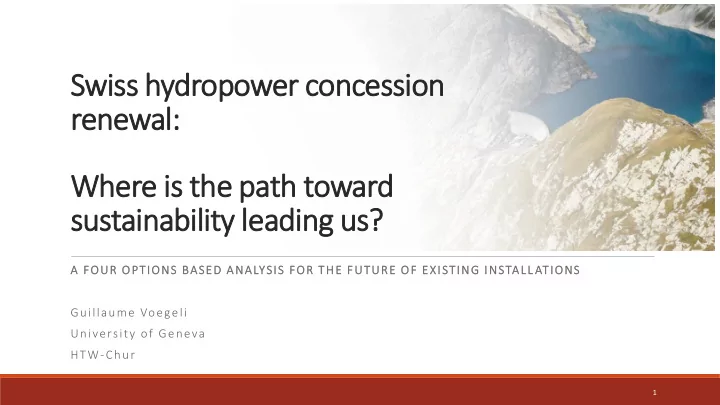

Swiss hydropower concession renewal: Where is the path toward sustainability leading us? A FOUR OPTIONS BASED ANALYSIS FOR THE FUTURE OF EXISTING INSTALL ATIONS Guillaume Voegeli University of Geneva HTW-Chur 1
Concession renewal in Switzerland: An imminent issue • Between 2030 and 2050, 20 TWh of annual production will be concerned by concession renewal in Switzerland (national production for 2016, approx. 58.7 TWh) • Following the Swiss law, the demand for concession renewal has to be presented 15 years before the end of the concession • The concession renewal opens a window of opportunity, to bring changes and alternatives for decisions that will most likely shape the face of the Swiss Alps for the next decades Source: SWV, 2012 Heimfall und Neukonzessionierung von Wasserkraftwerken 2
Sustainability assessment of hydropower, how necessary? • Long lasting, investment intensive and potentially harmful for environment and local people • Sustainability assessment (SA) allow to adopt a holistic and global perspective • SA provides decision makers with information on environmental, social and economic aspects. 3
What tool has been used for our SA? Use of Multiple Criteria Decision Analysis (MCDA) • Evaluate the performance of each alternative, based on a list of criteria • Standardize indicators of various kind • Integrate preferences and weights on criteria 4
The criteria We considered 4 dimensions, 11 criteria and 26 indicators Environment Technic Economy Social Natural disasters and Aggregated water quality Financial aspects of Provision of risks of infrastructure infrastructure side services Land availability (internal economic) Gases, radiations and Aesthetic impact of infrastructure noise emissions Provision of Rent transfer electricity and (external economic) Quality of aggregated power services Employment ecosystems and biodiversity 5
The case study Hydropower plant of Val d’Ambra (TI, CH) • The plant was a project which has recently been abandoned. We consider it has been built • Calculations and data used are mainly based on the company‘s technical reports realized at the time (2004-2005) • 4 alternatives are being considered: 1. Status quo (50 MW installed capacity) 2. Upgrading the facility (increase of 20MW) 3. Abandoning the infrastructure 4. Decommissioning the infrastructure 6
Details on the evaluation process • Two hypothesis : 1. For the four environmental criteria, natural state the most enviable state 2. The status quo alternative is used as a benchmark, as the infrastructure is considered existent (performance =0) • Standardization of performance 1. Based on the status quo, +/- 1 always represents the performance of the most extreme option, regarding specifically each criterion 2. The performances of other alternatives in between are given a relative value [0 < x < +/-1 ] 7
Managing uncertainty Uncertainty remain very large in every step of the evaluation process. We considered the following aspects: • Uncertainty on the performance of each option, for each criteria by setting a range in terms of performance • Uncertainty regarding the weighting of each criteria by setting 42 different weighting configuration • Uncertainty regarding various optimality approaches by considering 3 different approaches (SAW, TOPSIS, Dominance) 8
Results 9
Results • In only 13% of the cases, the status quo was ranked as the best option • However, nearly two third of the cases, it was ranked as the second best option • The pattern of the updating and decommissioning options are very close together. • In more than 80 % of the cases, one of the two was ranked as the best option • While decommissioning is more often considered as the best option (43%), it is also “more often” considered as the third (44%) and worst option (10%) • Abandoning the dam is only ranked as the best option in only 4% of the cases. For more than 70% of them, it is considered as the worst option 10
Discussing the results It’s only a case study, but following issues need to be raised: • Following the results, it seems that the upgrading and decommissioning options should seriously be considered in the case of a concession renewal • Abandoning the infrastructure should be motivated as such, and be considered as a equal alternative to others • In our case, the status quo alternative, while not the best option for most of the time, it ensures for more than 75% of the time to be in the two best options – a more robust choice? 11
Conclusion • Some uncertainty can be restrained 1. Increasing the quality of information regarding the parameters and the alternatives 2. Increasing the quality and availability of weighting information from e.g. stakeholders and concerned people, in order to give more sense to the parameters • The role of MCDA is not to take a decision, but to provide decision makers with relevant information. • It can show the most robust option, or the one that performs the best in one specific configuration of weighting, etc. • What path for future development? • To a probabilistic and modelling development? • To the decreased of uncertainty, with inclusion of stakeholder perceptions (e.g. interview processes, etc.) • Or both? 12
Thanks for your attention ! 13
Recommend
More recommend